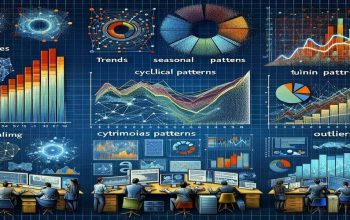Performance analytics tools increasingly shape and influence decision-making processes in businesses across the globe. Empowered by data, these solutions help enterprises redefine productivity and efficiency. Keep reading as we take a deep dive into performance analytics tools and their significant influence on productivity.
Understanding Performance Analytics Tools
Alt text: A man in an office using performance analytics tools on his computer
Performance analytics tools accumulate, analyze, and present data concerning business operations. They encapsulate various forms of data in a user-friendly manner, enabling stakeholders to make informed corporate decisions.
The primary purpose of these tools is to offer insights into the operational performance of an organization. Executives can gauge their performances against set benchmarks or other companies, directly impacting overall productivity.
Crucially, performance analytics tools enable businesses to convert raw data into actionable insights, leading to an overall enhanced business performance.
These tools can reveal hidden issues obstructing productivity and give leadership the tools to make strategic changes. Companies that adopt and integrate these analytics into their operational strategies are typically better positioned for success.
Ways Performance Analytics Tools Can Boost Productivity
Performance analytics tools have a direct correlation with a company’s productivity. Employing these tools provides immediate visibility into business operations, facilitating quick identification of productivity barriers.
This technology also encourages efficiency as employees can monitor their performance in real time, steering them toward optimal productivity.
Moreover, performance analytics tools monitor the effectiveness of corporate policies allowing for better workforce management and productivity optimization strategies.
Lastly, these tools offer predictive capabilities, forecasting possible outcomes based on present data. This predictability means that businesses can proactively manage potential productivity pitfalls before they become actual issues.
Case Studies of Performance Analytics Tools in Action
Many major corporations attribute their success to the implementation of performance analytics tools. For instance, some global retailers used these tools to streamline their supply chain operations, significantly enhancing productivity by reducing downtime.
In healthcare, people can harness these tools in managing staff schedules and patient appointments, enhancing productivity by reducing wait times and improving patient care.
Internationally recognized industries such as finance have also reaped the benefits of these tools, streamlining complex procedures and pinpointing productivity bottlenecks.
These examples only represent a fraction of how performance analytics tools have profoundly affected productivity across various sectors.
Choosing the Right Performance Analytics Tool for Your Business
Selecting the right performance analytics tool is contingent on your business’s needs. Factors to consider include ease of integration, scalability, customizability, and the ability to produce real-time data.
In addition, looking out for solutions that offer robust reporting features is vital. Such a tool should enable businesses to interpret and use data most beneficially.
Favorably, the market offers a plethora of options suited to different business models, whether start-ups or large-scale multinational corporations.
Whatever your choice, the importance of comprehensive research and careful consideration to select the most beneficial tool cannot be overemphasized.
Future Trends of Performance Analytics Technology
Alt text: A team in an office on their computers using performance analytics tools
The future of performance analytics technology looks promising with innovations poised to offer even greater insights. Expect to see enhanced predictive capacities, deeper integration with other technologies, and extensive usage of artificial intelligence and machine learning.
The rise of big data is likely to amplify the relevance and importance of performance analytics tools even further.
In the future, performance analytics tools might be able to offer data analysis in real-time – an evolution that could serve to enhance decision-making and productivity considerably.
Last but not least, as businesses increasingly embrace digital transformation, performance analytics tools will likely become an intrinsic part of most businesses’ daily operations.
Overall, the adoption and application of performance analytics tools represent a strategic move for businesses looking to maximize productivity. As an evolving technology, these tools promise to deliver even greater benefits in the future.




